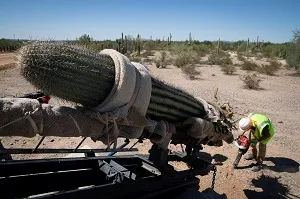
Organ Pipe National Monument.
CBP photo by Jerry Glaser
While building a vital section of the border wall, U.S. Customs and Border protection is preserving the namesake of a national monument. As of Oct. 16, specialized crews relocated a total of 144 plants to include 105 saguaro, two organ pipes, 13 ocotillo, one senita, 16 hedgehog, and seven barrel cacti from the Roosevelt Reservation, as part of the new border wall project and infrastructure improvements at the border on the Organ Pipe Cactus National Monument near Lukeville, Arizona.
“We strive to protect our nation’s border and preserve the historical, cultural, and natural beauty of the environments in which we work and communities we live in,” said Roy Villareal, Tucson, Arizona, Sector Chief Patrol Agent. “The cacti relocation project on the Organ Pipe Cactus National Monument is a great example of our efforts and commitment to protecting the ecosystems of the uniquely beautiful Sonoran Desert.”
“CBP and the National Park Service have a long history of cooperatively managing environmental resources and border security in Organ Pipe Cactus National Monument and Coronado National Memorial in southern Arizona,” CBP and National Park Service officials said in a joint statement. “Over the last 10 years, we have worked closely together to identify strategies for protecting environmental resources within the parks by minimizing the footprint needed for border enforcement activities.”
As part of the current border infrastructure projects in the U.S. Border Patrol’s Tucson Sector, CBP worked closely with the National Park Service and the U.S. Army Corps of Engineers to have an arborist and saguaro specialist identify and inventory protected plants that have the potential to be impacted by the current border infrastructure projects. All plants are evaluated for health to determine if they can be relocated. For all plants determined to be healthy enough for relocation, CBP and the National Park Service identified areas within the park where they could be transplanted. The arborist will monitor the plants for 12 months to maximize survivability.
The strategies have been effective in not only protecting sensitive biological, cultural, and historical resources within the park, but have also been effective in increasing border security, which has allowed the park to restore public access to a number of park areas after several years of closure.
More than half the monument was closed to the public due to safety concerns from cross border illegal activity such as human and narcotic smuggling. Furthermore, the collaboration resulted in the restoration of approximately 111 miles of roads within designated wilderness areas in Organ Pipe Cactus National Monument that had deteriorated over time due to cross border illegal activities.
According to the National Park Service, saguaros are considered icons of the American west, growing to 45 feet in height with their distinctive “arms” reaching skyward. To the Tohono O’Odham people, the saguaro cacti are not plants, but a different type of humanity, and are viewed as respected members of the tribe.

